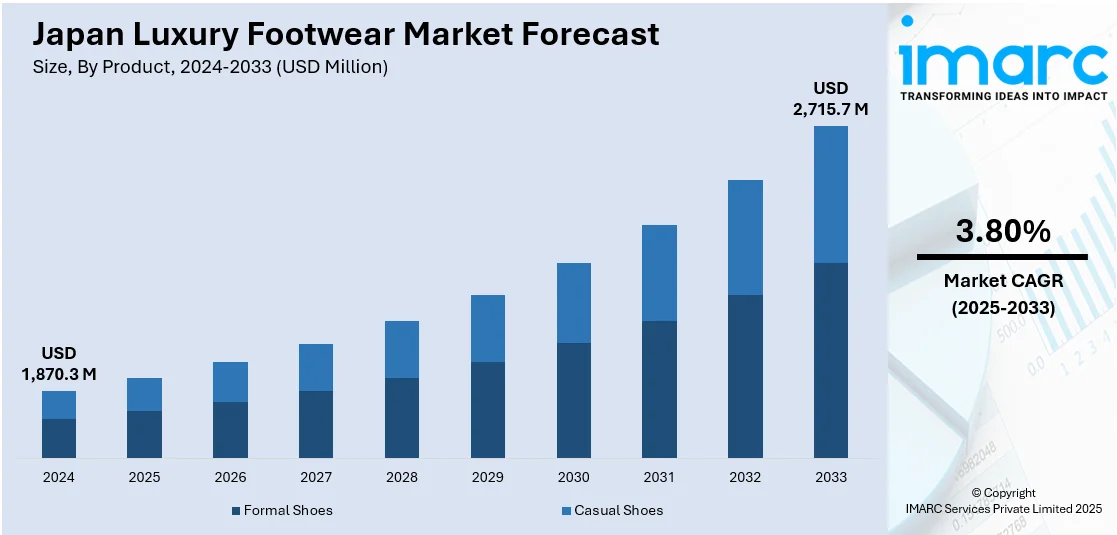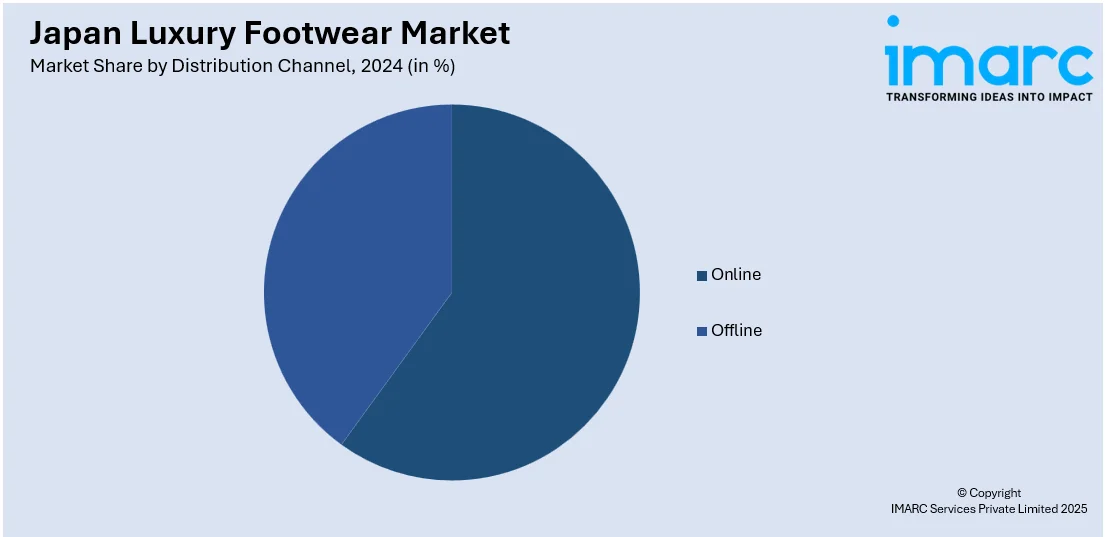
Japan Luxury Footwear Market Size, Share, Trends and Forecast by Product, Distribution Channel, End-User, and Region, 2025-2033
Japan Luxury Footwear Market Overview:
The Japan luxury footwear market size reached USD 1,870.3 Million in 2024. Looking forward, IMARC Group expects the market to reach USD 2,715.7 Million by 2033, exhibiting a growth rate (CAGR) of 3.80% during 2025-2033. The market is experiencing significant growth, driven by rising disposable incomes, fashion-forward consumers, and increasing brand consciousness. Additionally, high-end footwear brands, both domestic and international, are expanding their presence, contributing to the market growth across the country.
|
Report Attribute
|
Key Statistics
|
|---|---|
|
Base Year
|
2024
|
|
Forecast Years
|
2025-2033
|
|
Historical Years
|
2019-2024
|
| Market Size in 2024 | USD 1,870.3 Million |
| Market Forecast in 2033 | USD 2,715.7 Million |
| Market Growth Rate 2025-2033 | 3.80% |
Japan Luxury Footwear Market Trends:
Rising Brand Consciousness
In Japan, increasing brand awareness is fueling strong demand for high-end and high-status footwear brands. Consumers, especially the fashion-conscious and high-income segments, are increasingly turning to luxury footwear as a status symbol and a reflection of personal style. With increasing disposable incomes and a rising middle class, buying luxury products is becoming increasingly affordable for a larger population. This trend is being driven by the perception of luxury footwear as a symbol of superior craftsmanship, exclusivity, and high social status. Social media, celebrity endorsements, and influencer culture are playing a key role in influencing consumer attitudes, especially among young consumers who want to project their personal style. International and domestic luxury footwear brands are experiencing increasing demand. This trend towards premium, high-status footwear is playing a key role in driving Japan luxury footwear market growth.

Growth in Online and Omni-Channel Retailing
The Japanese luxury footwear market is experiencing a large-scale transition to omni-channel retailing and e-commerce sites, giving customers a convenient shopping experience. Luxury footwear brands, with online shopping becoming popular, are embracing combined offline-online approaches, enabling customers to view products online, purchase them, and collect them in stores. Not only does this increase customer convenience, but also makes the brand more accessible. Incorporation of virtual try-ons, personalization features, and limited online-only collections is also increasing the accessibility of luxury brands. Luxury stores are investing in improving websites and mobile apps to offer personalized recommendations and seamless checkout options. Luxury brands are embracing social media marketing to target young, tech-smart consumers. This trend will continue to spur growth in the industry, and the Japan luxury footwear market outlook remains positive with e-commerce and omni-channel efforts gaining pace.
Sustainability and Ethical Practices
Ethical production and sustainability are becoming key priority for Japanese luxury shoe companies as consumers become increasingly environmentally conscious. Businesses now employ eco-friendly materials such as recycled plastics, organic leathers, and green textiles to make their products, responding to the consumers' demand for greener products. Ethical production such as fair labor and ethical sourcing are also gaining traction, ensuring that the shoe is made in conditions that reflect social responsibility values. Moreover, most luxury businesses are concentrating their efforts on transparent supply chains, providing consumers with clear information on where and how their products are made. This concentration on sustainability not only attracts environmentally conscious consumers but also reflects global corporate responsibility trends.As consumer preferences shift towards brands that prioritize ethics and sustainability, these efforts are contributing to a growing Japan luxury footwear market share.
Japan Luxury Footwear Market Segmentation:
IMARC Group provides an analysis of the key trends in each segment of the market, along with forecasts at the regional level for 2025-2033. Our report has categorized the market based on product, distribution channel, and end user.
Product Insights:
- Formal Shoes
- Casual Shoes
The report has provided a detailed breakup and analysis of the market based on the product. This includes formal shoes and casual shoes.
Distribution Channel Insights:

- Online
- Offline
A detailed breakup and analysis of the market based on the distribution channel have also been provided in the report. This includes online and offline.
End User Insights:
- Men
- Women
- Children
A detailed breakup and analysis of the market based on the end user have also been provided in the report. This includes men, women, and children.
Regional Insights:
- Kanto Region
- Kansai/Kinki Region
- Central/Chubu Region
- Kyushu-Okinawa Region
- Tohoku Region
- Chugoku Region
- Hokkaido Region
- Shikoku Region
The report has also provided a comprehensive analysis of all the major regional markets, which include Kanto Region, Kansai/Kinki Region, Central/Chubu Region, Kyushu-Okinawa Region, Tohoku Region, Chugoku Region, Hokkaido Region, and Shikoku Region.
Competitive Landscape:
The market research report has also provided a comprehensive analysis of the competitive landscape. Competitive analysis such as market structure, key player positioning, top winning strategies, competitive dashboard, and company evaluation quadrant has been covered in the report. Also, detailed profiles of all major companies have been provided.
Japan Luxury Footwear Market News:
- In February 2025, AMIRI and Maison MIHARA YASUHIRO launched a limited-edition sneaker that fuses rock ‘n’ roll style with high-end streetwear. Featuring unique handcrafted soles and bold designs, the collaboration celebrates both brands' legacies and is available exclusively at select stores worldwide.
- In December 2024, Onitsuka Tiger, a Japanese luxury footwear brand under Asics Corporation, is considering manufacturing in India to take advantage of the country's expanding premium footwear market. With strong double-digit growth and plans to open more stores, the brand seeks to increase its value through local production and make the most of the thriving e-commerce sector.
Japan Luxury Footwear Market Report Coverage:
| Report Features | Details |
|---|---|
| Base Year of the Analysis | 2024 |
| Historical Period | 2019-2024 |
| Forecast Period | 2025-2033 |
| Units | Million USD |
| Scope of the Report |
Exploration of Historical Trends and Market Outlook, Industry Catalysts and Challenges, Segment-Wise Historical and Future Market Assessment:
|
| Products Covered | Formal Shoes, Casual Shoes |
| Distribution Channels Covered | Online, Offline |
| End Users Covered | Men, Women, Children |
| Regions Covered | Kanto Region, Kansai/Kinki Region, Central/Chubu Region, Kyushu-Okinawa Region, Tohoku Region, Chugoku Region, Hokkaido Region, Shikoku Region |
| Customization Scope | 10% Free Customization |
| Post-Sale Analyst Support | 10-12 Weeks |
| Delivery Format | PDF and Excel through Email (We can also provide the editable version of the report in PPT/Word format on special request) |
Key Questions Answered in This Report:
- How has the Japan luxury footwear market performed so far and how will it perform in the coming years?
- What is the breakup of the Japan luxury footwear market on the basis of product?
- What is the breakup of the Japan luxury footwear market on the basis of distribution channel?
- What is the breakup of the Japan luxury footwear market on the basis of end user?
- What is the breakup of the Japan luxury footwear market on the basis of region?
- What are the various stages in the value chain of the Japan luxury footwear market?
- What are the key driving factors and challenges in the Japan luxury footwear?
- What is the structure of the Japan luxury footwear market and who are the key players?
- What is the degree of competition in the Japan luxury footwear market?
Key Benefits for Stakeholders:
- IMARC’s industry report offers a comprehensive quantitative analysis of various market segments, historical and current market trends, market forecasts, and dynamics of the Japan luxury footwear market from 2019-2033.
- The research report provides the latest information on the market drivers, challenges, and opportunities in the Japan luxury footwear market.
- Porter's five forces analysis assist stakeholders in assessing the impact of new entrants, competitive rivalry, supplier power, buyer power, and the threat of substitution. It helps stakeholders to analyze the level of competition within the Japan luxury footwear industry and its attractiveness.
- Competitive landscape allows stakeholders to understand their competitive environment and provides an insight into the current positions of key players in the market.
Need more help?
- Speak to our experienced analysts for insights on the current market scenarios.
- Include additional segments and countries to customize the report as per your requirement.
- Gain an unparalleled competitive advantage in your domain by understanding how to utilize the report and positively impacting your operations and revenue.
- For further assistance, please connect with our analysts.
 Request Customization
Request Customization
 Speak to an Analyst
Speak to an Analyst
 Request Brochure
Request Brochure
 Inquire Before Buying
Inquire Before Buying




.webp)




.webp)












